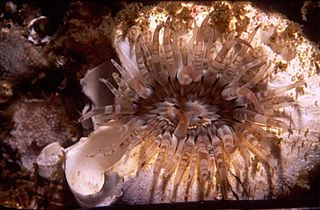
Cypraeovula fuscodentata is a species of medium-sized sea snail, a predatory marine gastropod mollusc in the family Cypraeidae, the cowries.

Corynactis annulata, or the strawberry anemone, is a bright pink colonial anthozoan similar in body form to sea anemones and scleractinian stony corals. This species is a solitary animal of the order Corallimorpharia.
The brooding anemone, Halianthella annularis, is a species of sea anemone in the family Halcampidae,.

Anthothoe chilensis, or striped anemone, is a species of sea anemones in the family Sagartiidae.

Anthostella stephensoni, the violet-spotted anemone, is a species of sea anemone in the family Actiniidae.

Bunodosoma capense, commonly known as the knobbly anemone, is a species of sea anemone in the family Actiniidae.

Pseudactinia flagellifera, the false plum anemone, is a species of sea anemone in the family Actiniidae. It is also a member of the kingdom, Animalia.

Anthopleura michaelseni, commonly known as the long-tentacled anemone or crevice anemone, is a species of sea anemone in the family Actiniidae. It is native to very shallow water round the coasts of southern Africa between Lüderitz and Durban.

Korsaranthus natalensis, commonly known as the spinnaker anemone or the candy-striped anemone, is a species of sea anemone in the family Actiniidae. It is the only member of its genus.

The sandy anemone is a species of sea anemone in the family Actiniidae. It is native to very shallow water round the coasts of southern Africa between Luderitz and Durban.

The multicoloured sea fan is a species of gorgonian sea fan in the family Melithaeidae.

The ring-tentacle anemone is a species of sea anemone in the family Isanthidae.

The Cape zoanthid is a species of zoanthid in the family Parazoanthidae.

Balanophyllia bonaespei is a species of solitary cup coral, a stony coral in the family Dendrophylliidae. It is an azooxanthellate species that does not contain symbiotic dinoflagellates in its tissues as most corals do.

The cauliflower soft coral is a species of colonial soft coral in the family Nephtheidae.

The nippled sea fanEunicella microthela previously known by the junior synonym Eunicella papillosa, is a species of gorgonian sea fan in the family Gorgoniidae.

The stalked trumpet jelly, is a species of stalked jellyfish in the family Depastridae. It is the only member of the genus Depastromorpha.

Stylaster nobilis, the noble coral, is a branching colonial hydroid in the family Stylasteridae.

The carpet flatworm is a polyclad flatworm in the family Pseudocerotidae.

Chirodactylus brachydactylus, the twotone fingerfin, is a species of marine fish in the fingerfin (morwongs) family of order Perciformes. It is native to the coast of southern Africa.




















